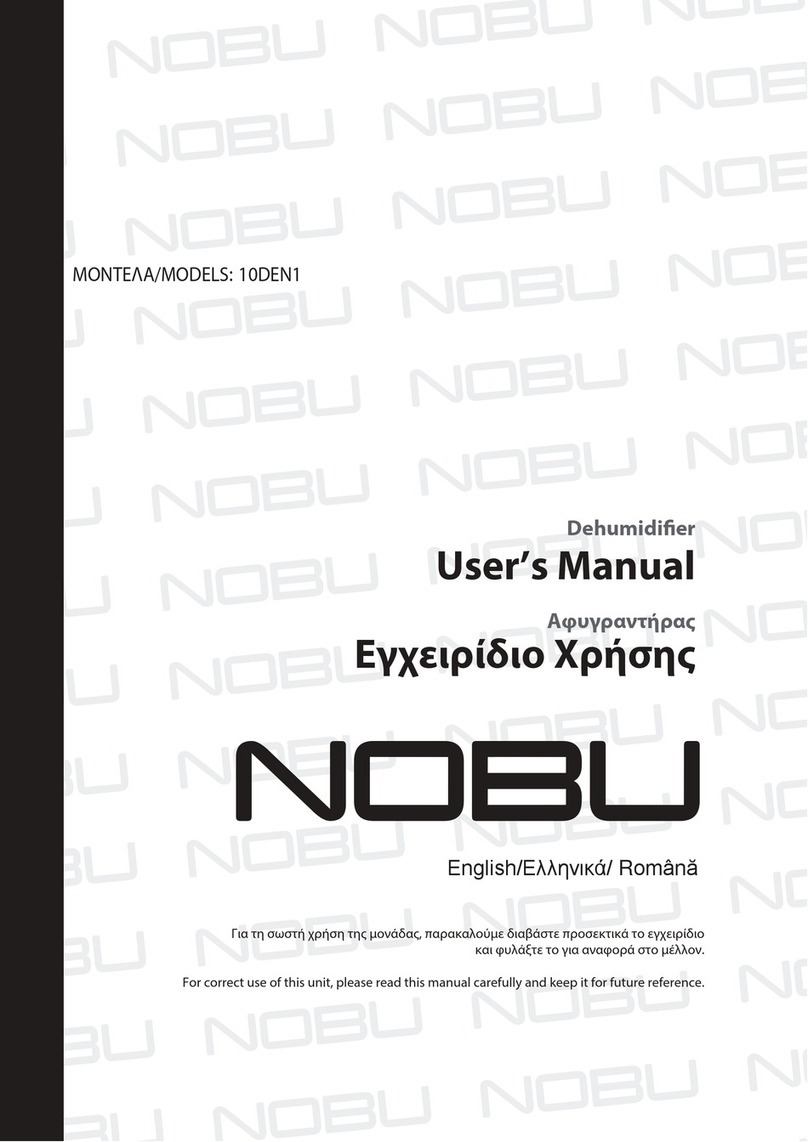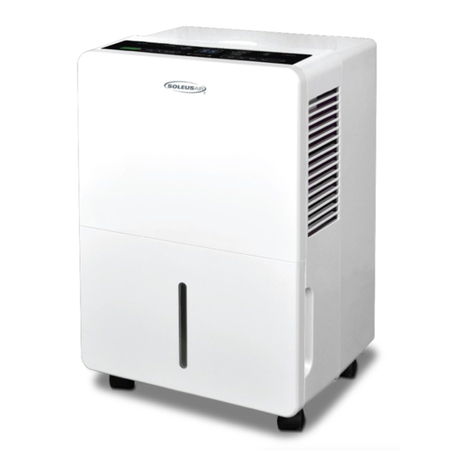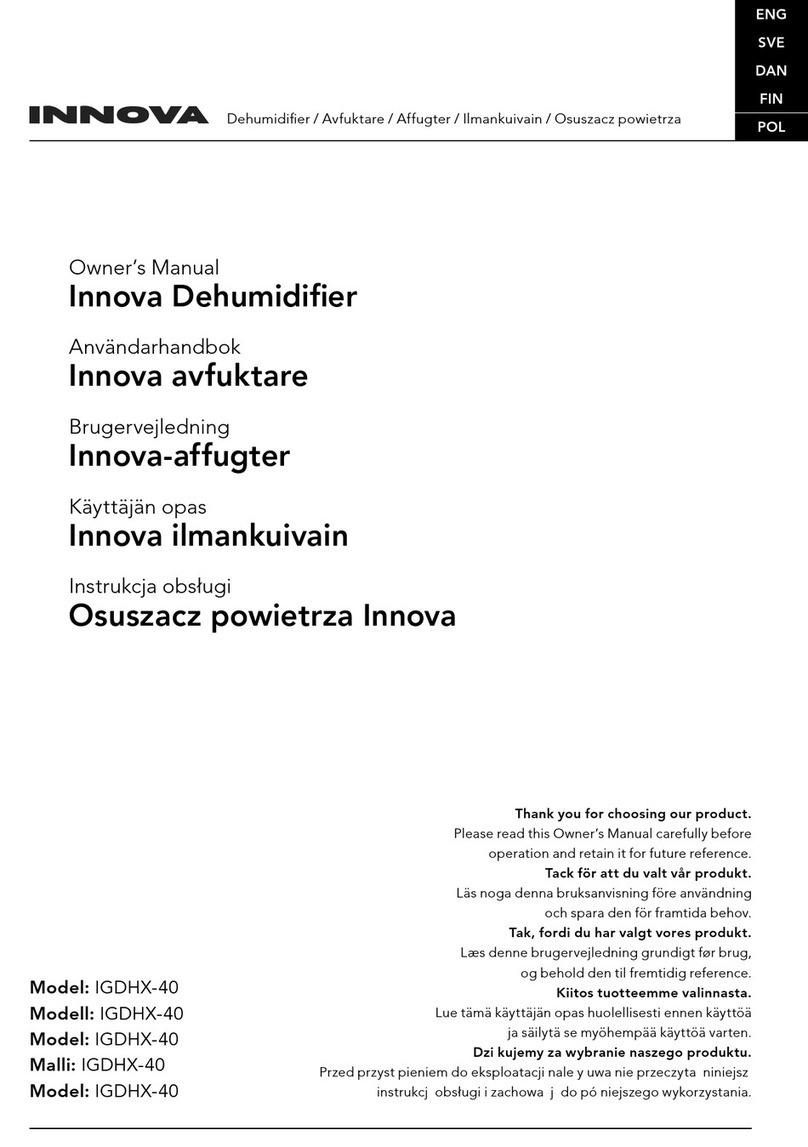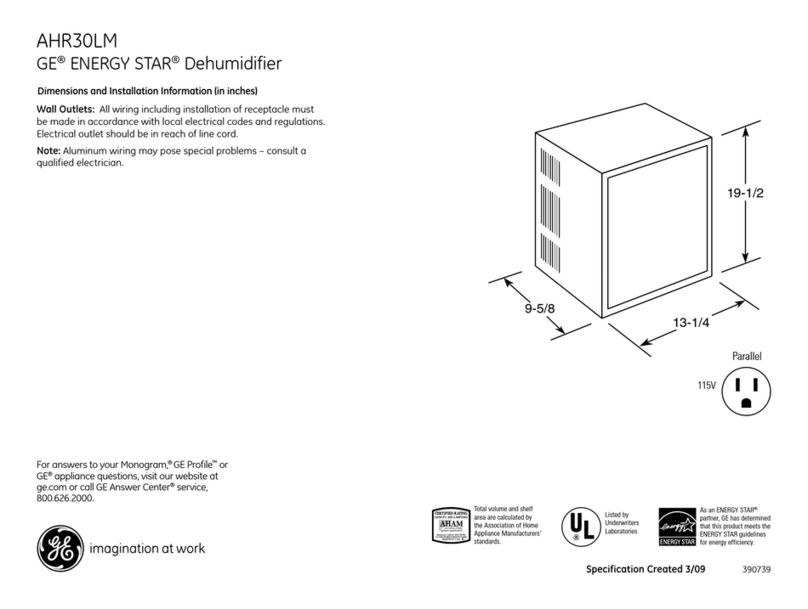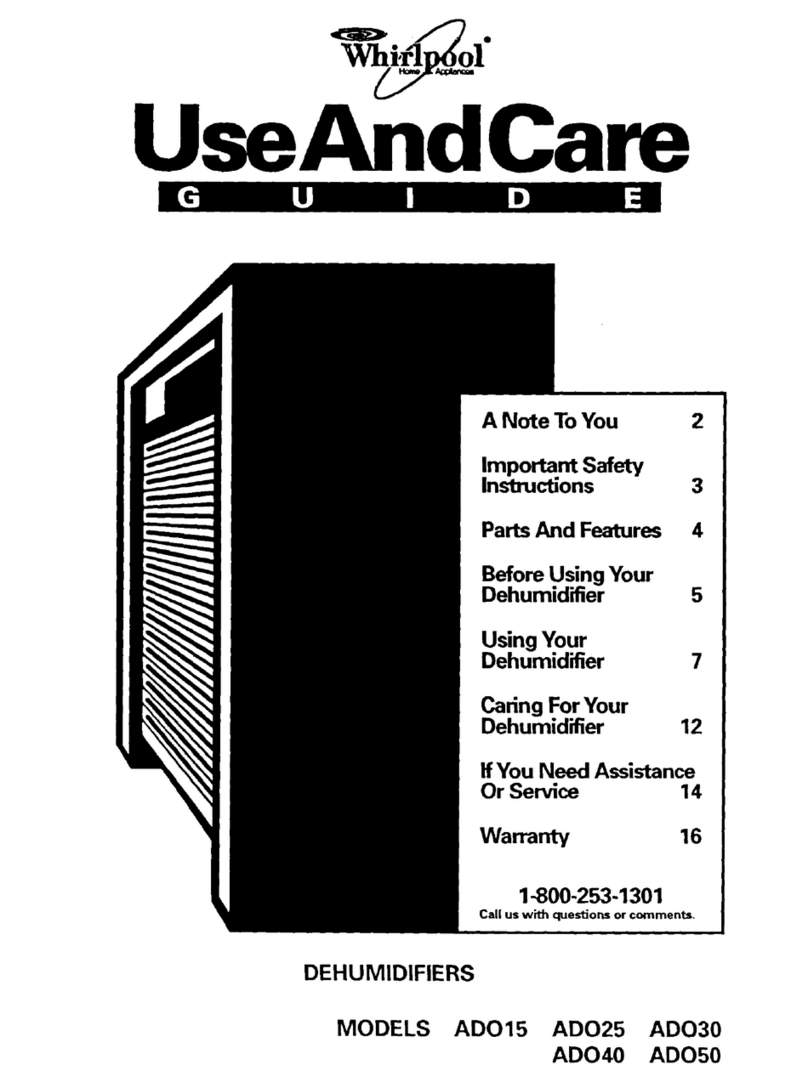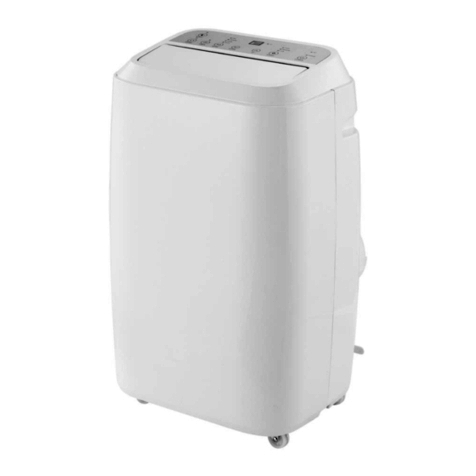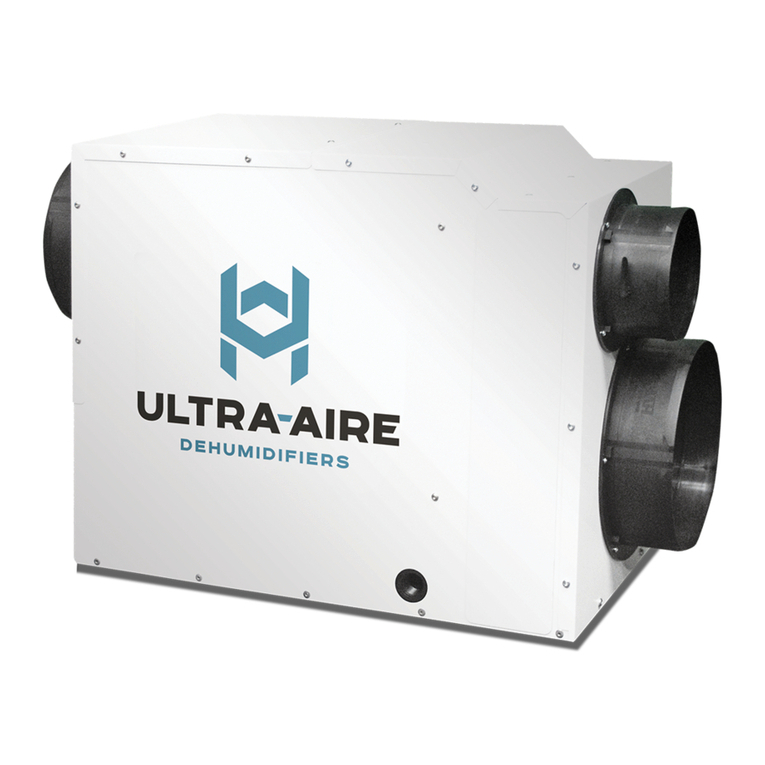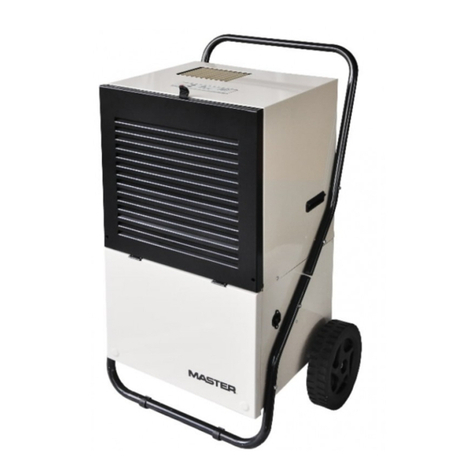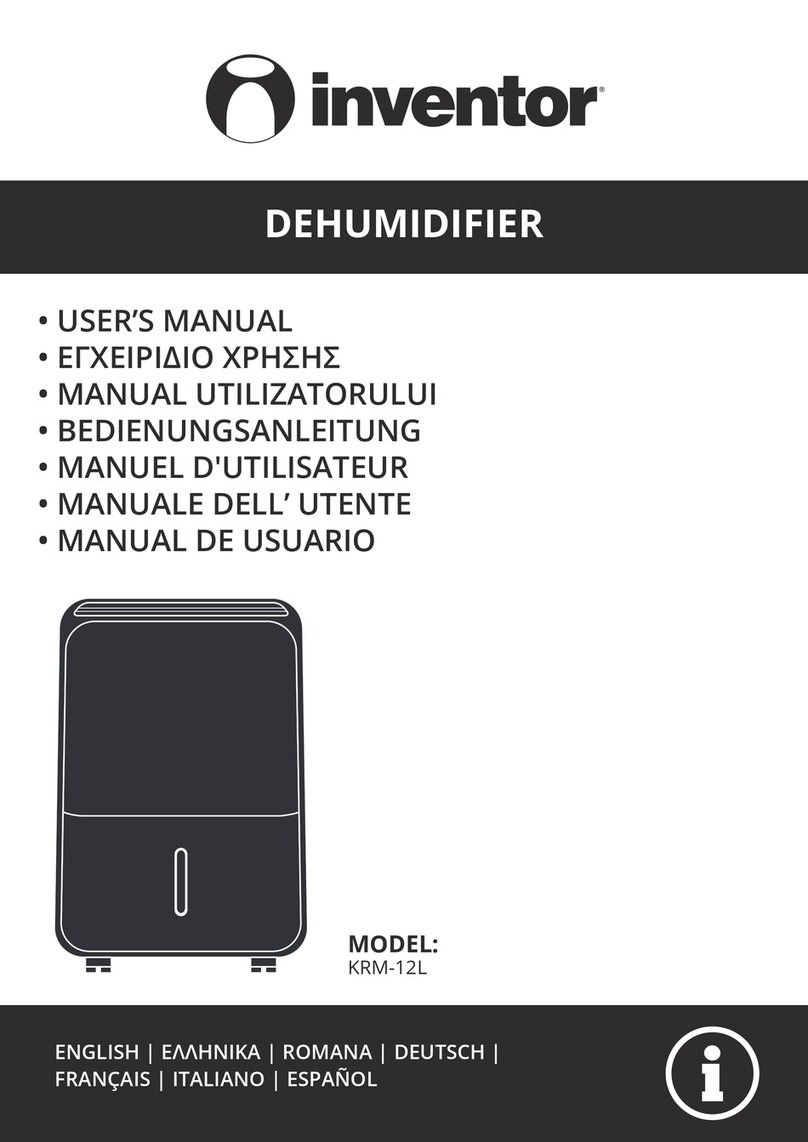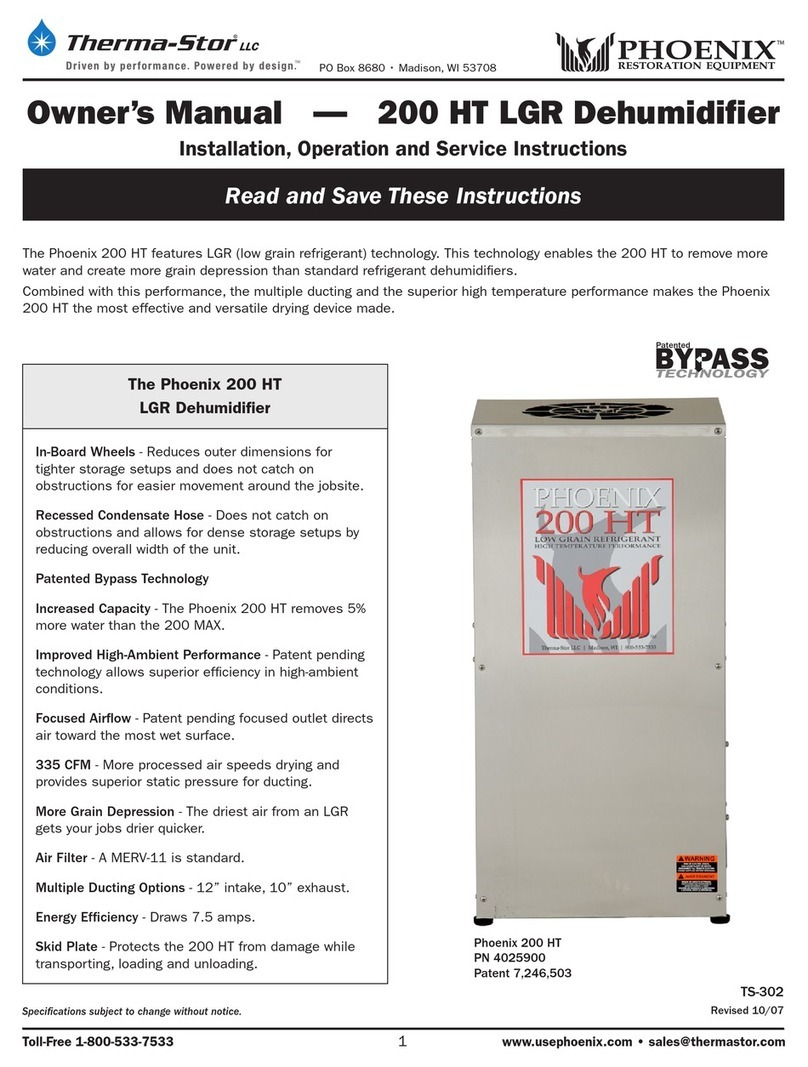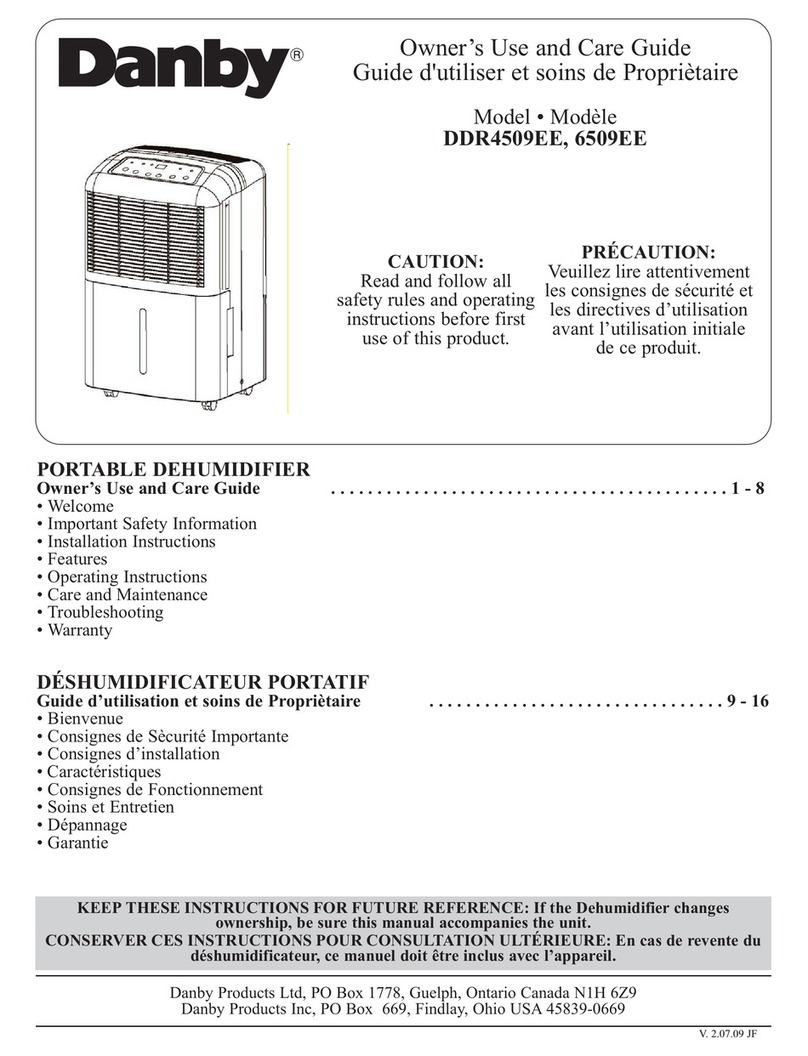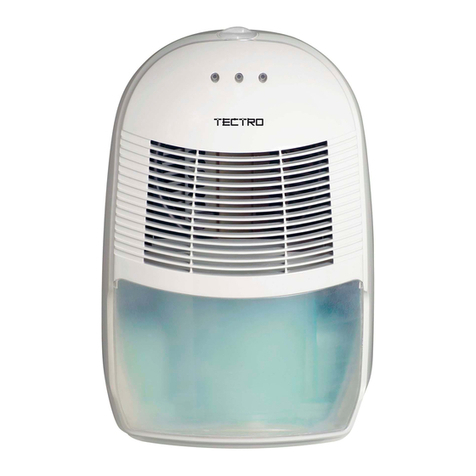Nobu AK-20L User manual

English/Ελληνικά/ Română
Για τη σωστή χρήση της μονάδας, παρακαλούμε διαβάστε προσεκτικά το εγχειρίδιο
και φυλάξτε το για αναφορά στο μέλλον.
For correct use of this unit, please read this manual carefully and keep it for future reference.
Pentru o utilizare corecta, va rugam sa cititi cu atentie acest manual
si sa il pastrati pentru o consultare ulterioara.
Αφυγραντήρας
Dehumidier
Εγχειρίδιο Χρήσης
Dezumidicator
Manual de utilizare
User’s Manual
AK-20L
ΜΟΝΤΕΛΑ/MODELS:


1
CONTENTS
Read This Manual
Inside you will nd many helpful hints on how to use and maintain your dehumidier properly.
Just a little preventive care on your part can save you a great deal of time and money over the
life of your dehumidier. You’ll nd many answers to common problems in the chart of trouble-
shooting tips. If you review our chart of Troubleshooting Tips rst, you may not need to call for
service at all.
SAFETY PRECAUTIONS ........................................................................................................3
SOCIABLE REMARKS ENVIRONMENTAL PROTECTION ................................................... 6
WARNINGS (for using R290/R32 refrigerant only) .............................................................. 7
CONTROL PADS ON THE DEHUMIDIFIER ......................................................................... 13
Control pads ........................................................................................................................... 13
Other features......................................................................................................................... 14
IDENTIFICATION OF PARTS ................................................................................................ 15
OPERATING THE UNIT.........................................................................................................16
Positioning the unit ................................................................................................................. 16
When using the unit ................................................................................................................ 16
Removing the collected water ................................................................................................ 17
CARE AND MAINTENANCE .................................................................................................18
Care and cleaning of the dehumidier ................................................................................... 18
TROUBLESHOOTING TIPS..................................................................................................19


3
SAFETY PRECAUTIONS
To prevent injury to the user or other people and property damage, the following
instructions must be followed. Incorrect operation due to ignoring of instructions may cause
harm or damage.
lThe seriousness is classied by the following indications.
!WARNING This symbol indicates the possibility of death or serious injury.
CAUTION
This symbol indicates the possibility of injury or damage to
property.
lMeanings of symbols used in this manual are as shown below.
Never do this.
!Always do this.
!WARNING
Do not exceed the rating of the power outlet or connection device.
Otherwise, it may cause electric shock or re due to excess heat generation.
Do not operate or stop the unit by switching on or o the power supply.
It may cause electric shock or re due to heat generation.
Do not damage or use an unspecied power cord.
It may cause electric shock or re.
Do not modify power cord length or share the outlet with other appliances
It may cause electric shock or re due to heat generation
Do not insert or pull out plug with wet hands.
It may cause electric shock.
Do not place the unit near a heat source.
Plastic parts may melt and cause a re.
!Disconnect the power if strange sounds, smell, or smoke comes from it.
It may cause re and electric shock.
You should never try to take apart or repair the unit by yourself.
It may cause failure of machine or electric shock.
! Before cleaning, turn o the power and unplug the unit.
It may cause electrical shock or injury.
Do not use the machine near ammable gas or combustibles, such as gasoline,
benzene, thinner, etc.
It may cause an explosion or re.
Do not drink or use the water drained from the unit.
It contains contaminants and could make you sick.
Do not take the water bucket out during operation.
It may cause bucket full protect of the unit and cause electric shock.

4
SAFETY PRECAUTIONS
!CAUTION
Do not use the unit in small spaces
Lack of ventilation can cause overheating and re.
Do not put in places where water may splash onto the unit
Water may enter the unit and degrade the insulation. It may cause an electric shock or re.
! Place the unit on a level sturdy section of the oor.
If the unit falls over, it may cause water to spill and damage belongings, or cause electrical
shock or re.
Do not cover the intake or exhaust openings with cloths or towels.
A lack of air ow can lead to overheating and re.
!Care should be taken when using the unit in a room with the following persons:
Infants, children, elderly people, and people not sensitive to humidity.
Do not use in areas where chemicals are handled.
This will cause the unit deterioration due to chemicals and solvents dissolved in the air.
Never insert your nger or other foreign objects into grills or openings. Take special
care to warn children of these dangers.
It may cause electric shock or failure of appliance.
Do not place heavy object on the power cord and take care so that the cord is not
compressed.
There is danger of re or electric shock.
Do not climb up on or sit on the unit.
You may be injured if you fall or if the unit falls over.
! Always insert the lters securely. Clean lter once every two weeks.
Operation without lters may cause failure.
! If water enters the unit, turn the unit o and disconnect the power, contact a qualied
service technician.
It may cause failure of appliance or accident.
Do not place ower vases or other water container on top of the unit.
Water may spill inside the unit, causing insulation failure and electrical Shock or re
!CAUTION
• This appliance can be used by children aged from 8 years and above and persons with
reduced physical, sensory or mental capabilities or lack of experience and knowledge if they
have been given supervision or instruction concerning use of the appliance in a safe way and
understand the hazards involved. Children shall not play with the appliance. Cleaning and
user maintenance shall not be made by children without supervision. (be applicable for the
European Countries )
• This appliance is not intended for use by persons (including children) with reduced physical
,sensory or mental capabilities or lack of experience and knowledge, unless they have been
given supervision or instruction concerning use of the appliance by a person responsible
for their safety. Children should be supervised to ensure that they do not play with the
appliance. (be applicable for other countries except the European Countries )

5
SAFETY PRECAUTIONS
• If the supply cord is damaged, it must be replaced by the manufacturer, its service agent or
similarly qualied persons in order to avoid a hazard.
• The appliance shall be installed in accordance with national wiring regulations.
• The appliance with electric heater shall have at least 1 meter space to the combustible
materials.
• Contact the authorised service technician for repair or maintenance of this unit.
• Do not use the socket if it is loose or damaged.
• Do not operate your air conditioner in a wet room such as a bathroom or laundry room.
• Do not use this product for functions other than those described in this instruction manual
• Contact the authorised installer for installation of this unit.
• If the air conditioner is knocked over during use, turn o the unit and unplug it from the
main power supply immediately. Visually inspect the unit to ensure there is no damage.
If you suspect the unit has been damaged, contact a technician or customer service for
assistance.
• In a thunderstorm, the power must be cut o to avoid damage to the machine due to
lightning.
• To reduce the risk of re or electric shock, do not use this fan with any solid-state speed
control device.
• Do not run cord under carpeting. Do not cover cord with throw rugs, runners, or similar
coverings. Do not route cord under furniture or appliances. Arrange cord away from trac
area and where it will not be tripped over.
• Do not open the unit during operation.
• When the air lter is to be removed, do not touch the metal parts of the unit.
• Hold the plug by the head of the power plug when taking it out.
l Electrical Information
• The manufactures nameplate is located on the rear panel of the unit and contains electrical
and other technical data specic to this unit.
• Be sure the unit is properly grounded. To minimize shock and re hazards, proper
grounding is important. The power cord is equipped with a three-prong grounding plug for
protection against shock hazards.
• Your unit must be used in a properly grounded wall receptacle. If the wall receptacle
you intend to use is not adequately grounded or protected by a time delay fuse or circuit
breaker(the fuse or circuit breaker needed is determined by the maximum current of the
unit. The maximum current is indicated on the nameplate located on unit), have a qualied
electrician install the proper receptacle.
• Ensure the receptacle is accessible after the unit installation.
• Do not use extension cords or an adapter plugs with this unit. However, if it is necessary to
use an extension cord, use an approved Dehumidier extension cord only (available at most
local hardware stores).
• To avoid the possibility of personal injury, always disconnect the power supply to the unit,
before installing and/or servicing.
• All wiring must be performed strictly in accordance with the wiring diagram located on the
middle bae of the unit (behind the water bucket).

6
SAFETY PRECAUTIONS
l Take note the fuse specications
The unit s circuit board (PCB) is designed with a fuse to provide overcurrent protection. The
specications of the fuse are printed on the circuit board, such as: T 3.15A/250V (or 350V),
etc.
NOTE: All the pictures in the manual are for explanation purposes only. The actual shape of
the unit you purchased may be slightly dierent, but the operations and functions are the
same.
Note About Fluorinated Gasses
-Fluorinated greenhouse gases are contained in hermetically sealed equipment. For specic
information on the type, the amount and the CO2 equivalent in tonnes of the uorinated
greenhouse gas (on some models), please refer to the relevant label on the unit itself.
-Installation, service, maintenance and repair of this unit must be performed by a certied
technician.
-Product uninstallation and recycling must be performed by a certied technician.
• Upon rst use and for proper calibration, please allow unit to operate
continuously for 24 hours.
Power o the dehumidier before removing the plug.
SOCIABLE REMARKS ENVIRONMENTAL PROTECTION
Disposal of equipment no longer used:
Please follow the instructions below, when using this dehumidier in European countries.
lThis appliance requires special treatment for disposal. In the European Union, electronic
equipment must not be treated as domestic waste, but must be disposed of professionally
in accordance with Directive 2002/96/EC of the European Parliament and Council of 27th
January 2003 concerning old electrical and electronic equipment.
The disposal of this unit should follow all legal requirements and should not be disposed as
unsorted municipal waste.
The hazardous substances can leak into the ground water supply thus entering the food
chain, endangering your health and the environment.
lFluorinated Greenhouse Gasses are contained in hermetically sealed equipment. For
specic information regarding the type the amount and the CO2equivalent in tons, please
refer to the relevant labels of the unit.
l There are several alternative solutions for disposal:
A) Your local municipality has established free collection systems for electronic
waste.
B) Your local retailer upon purchase of a new product.
C) The manufacturer may accept the old appliance for disposal.
D) Old appliances sometimes contain valuable resources for scrap metal dealers.

7
WARNINGS (for using R290/R32 refrigerant only)
-Do not use any other means other than the recommended to expedite the defrosting process
or to perform a cleaning of the unit, other than those recommended by the manufacturer.
- This device should never be stored in an area in combination with other ignition sources (for
example: a gas appliance an electrical heater, open ames etc.)
- Do not attempt to penetrate the unit with a tool or try to burn
- Be extra cautious as refrigerant gas may be odorless.
-Appliance should be installed, operated and stored in a room with a oor area larger than
4m2.
- It is necessary to always comply with national gas regulations.
- Keep air ventilation clear of any obstructions
- The unit should be placed in storage in such a manner as to prevent any mechanical damage
from occurring.
- Always operate this unit in a well-ventilated area, where the room size corresponds to the
specications of the device for optimal performance.
-Any persons involved with the operation and handling of the refrigerant circuit of this unit,
should be certied by the related accredited industry, and authorized as competent to handle
refrigerants, safely, and in accordance to the safety standards of the industry.
- Servicing should be performed only by a certied technician as per the Mnaufacturers
reccomendations. Any maintenance or repair required, should be performed by skilled
personnel who are competent in the use of ammable refrigerants.
IMPORTANT NOTE: Please read this manual
carefully prior to installing and operating
your device! It is recommended to keep this
manual for future reference.
Caution: Risk of re/
ammable materials (Required
for R32/R290 units only)
Description of displayed Symbols (*Only applicable to units with R32/R290 Refrigerant)
WARNING This symbol indicates the use of a ammable refrigerant. If any
leakage occurs, or if exposed to an external ignition source, a re risk is
possible.
CAUTION This symbol indicates that the user’s manual should be read carefully.
CAUTION This symbol indicates that a professional service technician should
handle this unit with reference to the user’s manual
CAUTION This symbol indicates the presence of a user’s or installation manual

8
WARNINGS (for using R290/R32 refrigerant only)
! Warnings (for using R290/R32 refrigerant only)
1. Transport of equipment containing ammable refrigerants
Determined by local regulations.
2.Marking of equipment using signs
See local regulations
3. Discarded appliances supplies ammable refrigerants
See National Regulations.
4. Storage of equipment/appliances
The storage of equipment should be in accordance with the manufacturer’s instructions.
5. Storage of packed (unsold) equipment
Storage package protection should be constructed such that mechanical damage to the
equipment inside the package will not cause a leak of the refrigerant charge.
The maximum number of pieces of equipment permitted to be stored together will be
determined by local regulations.
6.Information on servicing
1. Checks to the area
Prior to beginning work on systems containing ammable refrigerants, safety checks are
necessary to ensure that the risk of ignition is minimized. For repair to the refrigerating
system, the following precautions shall be complied with prior to conducting work in the
system.
2. Work procedure
Work shall be undertaken under a controlled procedure so as to minimize the risk of a
ammable gas or vapor being present while the work is being performed.
3. General work area
All maintenance sta and others working in the local area shall be instructed on the nature
of work being carried out. Work in conned spaces shall be avoided. The area around the
workspace shall be sectioned o. Ensure that the conditions within the area have been
made safe by control of ammable material.
4. Checking for presence of refrigerant
The area shall be checked with an appropriate refrigerant detector prior to and during work,
to ensure the technician is aware of potentially ammable atmospheres. Ensure that the
leak detection equipment being used is suitable for use with ammable refrigerants, i.e.
nonspeaking, adequately sealed or intrinsically safe.
5. Presence of re extinguisher
If any work is to be conducted on the refrigeration equipment or amy associated parts,
appropriate re extinguishing equipment shall be available to hand. Have a dry powder or
CO2 re extinguisher adjacent to the charging area.
6. No ignition sources
No person carrying out work in relation to a refrigeration system which involves exposing
any pipe work that contains or has contained ammable refrigerant shall use any sources of
ignition in such a manner that it may lead to the risk of re or explosion. All possible ignition
sources, including cigarette smoking, should be kept suciently far away from the site
of installation, repairing, removing and disposal, during which ammable refrigerant can
possibly be released to the surrounding space. Prior to work taking place, the area around

9
the equipment is to be surveyed to make sure that there are no ammable hazards or
ignition risks.”No Smoking” signs shall be displayed.
7. Ventilated area
the system or conducting any hot work. A degree of ventilation shall continue during the
period that the work is carried out. The ventilation should safely disperse any released
refrigerant and preferably expel it externally into the atmosphere.
8. Checks to the refrigeration equipment
Where electrical components are being changed, they shall be t for the purpose and
to the correct specication. At all times the manufacturer’s maintenance and service
guidelines shall be followed. If in doubt consult the manufacturer’s technical department for
assistance.
The following check shall be applied to installations using ammable refrigerants:
--the charge size is in accordance with the room size within which the refrigerant containing
parts are installed;
--the ventilation machinery and outlets are operating adequately and are not obstructed;
9. Checks to electrical devices
Repair and maintenance to electrical components shall include initial safety checks and
component inspection procedures. If a fault exists that could compromise safety, then no
electrical supply shall be connected to the circuit until it is satisfactorily dealt with. If the fault
cannot be corrected immediately but it is necessary to continue operation, an adequate
temporary solution shall be used . This shall be reported to the owner of the equipment so
all parties are advised.
Initial safety checks shall include:
--that capacitors are discharged; this shall be done in a safe manner to avoid possibility of
sparking;
--that there no live electrical components and wring are exposed while charging, recovering
or purging the system;
--that there is continuity of earth bonding.
7. Repairs to sealed components
During repairs to sealed components, all electrical supplies shall be disconnected from the
equipment being worked upon prior to any removal of sealed covers, etc. If it is absolutely
necessary to have an electrical supply to equipment during servicing, then a permanently
operating form of leak detection shall be located at the most critical point to warn of a
potentially hazardous situation.
Particular attention shall be paid to the following to ensure that by working in electrical
components, the casing is not altered in such a way that level of protection is aected. This
shall include damage to cables, excessive numble of connection, terminals not made to
original specication, damage to seals, incorrect tting of glands, etc.
Ensure that seals or sealing materials have not degraded such that they no longer serve the
purpose of preventing the ingress of ammable atmospheres. Replacement parts shall be in
accordance with the manufacturer’s specications,
NOTE The use of silicon sealant may inhibit the eectiveness of some types of leak detection
equipment. Intrinsically safe components do not have to be isolated prior to working on
them.
8. Repair to intrinsically safe components
Do not apply any permanent inductive or capacitance loads to the circuit without ensuring
that this will not exceed the permissible voltage and current permitted for the equipment in
use.
WARNINGS (for using R290/R32 refrigerant only)

10
9. Cabling
Check that cabling will not be subject to wear, corrosion, excessive pressure, vibration, sharp
edges or any other adverse environmental eects. The check shall also take into account the
eects of aging or continual leaks. A halide torch (or any other detector using a naked ame)
shall not be used
10. Detection of ammable refrigerants
Under no circumstances shall potential sources of ignition be used in the searching for or
detection of refrigerant leaks. A halide torch (or any other detector using a naked ame)
shall not be used.
11. Leak detection methods
The following leak detection methods are deemed acceptable for systems containing
ammable refrigerants.
Electronic leak detectors shall be used to detect ammable refrigerants, but the sensitivity
may not be adequate, or may need re-calibrated.(Detection equipment shall be calibrated
in a refrigerant-free area.) Ensure that the detector is not a potential source of ignition and
is suitable for the refrigerant used. Leak detection equipment shall be set at a percentage
of the LFL of the refrigerant and shall be calibrated to the refrigerant employed and the
appropriate percentage of gas(25% maximum )is conrmed .
Leak detection uids are suitable for use with most refrigerants but the use of detergents
containing chlorine shall be avoided as the chlorine shall be avoided as the chlorine may
react with the refrigerant and corrode the copper pipe work.
If a leak is suspected, all naked ames shall be removed/extinguished.
If a leakage of refrigerant is found which requires brazing, all of the refrigerant shall be
recovered from the system, or isolated (by means of shut o valves) in a part of the system
both before and during the brazing process.
12. Removal and evacuation
When breaking into the refrigerant circuit to make repairs- or for any other purpose –
conventional procedures shall be used. However, it is important that best practice is
followed since ammability is a consideration. The following procedure shall be adhered to:
remove refrigerant;
purge the circuit with inert gas;
evacuate;
purge again with inert gas;
open the circuit by cutting or brazing;
The refrigerant charge shall be recovered into the correct recovery cylinders. The system
shall be “ushed’ with OFN to render the unit safe. This process may need to be repeated
several times. Compressed air or oxygen shall not be used for this task.
Flushing shall be achieved by breaking the vacuum in the system with OFN and continuing
to ll until the working pressure is achieved, then venting to atmosphere, and nally pulling
down to a vacuum. This processing shall be repeated until no refrigerant is within the
system. When the nal OFN charge is used, the system shall be vented down to atmospheric
pressure to enable work to take place. This operation is absolutely vital if brazing operations
on the pipe-work are to take place. Ensure that the outlet for the vacuum pump is not close
to any ignition sources and there is ventilation available.
13. Charging procedures
In addition to conventional charging procedures, the following requirements shall be
followed.
WARNINGS (for using R290/R32 refrigerant only)

11
-Ensure that contamination of dierent refrigerants does not occur when using charging
equipment. Hoses or lines shall be as short as possible to minimize the amount of
refrigerant contained in them.
-Cylinders shall be kept upright.
-Ensure that the refrigeration system is earthed prior to charging the system with
refrigerant.
-label the system when charging is complete (if not already)
-Extreme care shall be taken not to overll the refrigeration system.
Prior to recharging the system is shall be pressure tested with OFN. The system shall be leak
tested on completion of charging but prior to commissioning. A follow up leak test shall be
carried out prior to leaving the site.
14. Decommissioning
Before carrying out this procedure, it is essential that the technician is completely familiar
with the equipment and all its detail. It is recommended good practice that all refrigerants
are recovered safely. Prior to the task being carried out, an oil and refrigerant sample shall
be taken is case analysis is required prior to re-use of reclaimed refrigerant. It is essential
that electrical power is available before the task is commenced.
a) become familiar with the equipment and its operation.
b) Isolate system electrically.
c) Before attempting the procedure ensure that;
Mechanical handling equipment is available and being used correctly; the recovery process
is supervised at all times by a competent person; recovery equipment and cylinders
conform to the appropriate standards.
d) Pump down refrigerant system, if possible.
e) If a vacuum is not possible , make a manifold so that refrigerant can be removed from
various parts of the system.
f) Make sure that cylinder is situated on the scales before recovery takes place.
g) Start the recovery machine and operate in accordance with manufacturer’s instructions.
h) Do not overll cylinders. (No more than 80% volume liquid charge).
i) Do not exceed the maximum working pressure of the cylinder, even temporarily.
j) When the cylinders have been lled correctly and the process completed, make sure
that the cylinders and the equipment are removed from site promptly and all isolation
valves on the equipment are closed o.
k) Recovered refrigerant shall not be charged into another refrigeration system unless it
has been cleaned and checked.
15. Labeling
Equipment shall be labeled stating that it has been de-commissioned and emptied of
refrigerant. The label shall be dated and signed. Ensure that there are labels on the
equipment stating the equipment contains ammable refrigerant.
16. Recovery
When removing refrigerant from a system, either for servicing or decommissioning, it is
recommended good practice that all refrigerant into cylinders, ensure that only appropriate
refrigerant recovery cylinders are employed. Ensure that the correct number of cylinders for
holding the total system charge are available. All cylinders to be used are designated for the
recovered refrigerant and labeled for that refrigerant(i.e special cylinders for the recovery
of refrigerant). Cylinders shall be complete with pressure relief valve and associated shut-
o valves in good working order. Empty recovery cylinders are evacuated and , if possible,
cooled before recovery occurs.
WARNINGS (for using R290/R32 refrigerant only)

12
WARNINGS (for using R290/R32 refrigerant only)
The recovery equipment shall be in good working order with a set with a set of instructions
concerning the equipment that is at hand and shall be suitable for the recovery of
ammable refrigerants.
In addition, a set of calibrated weighing scales shall be available and in good working order.
Hoses shall be complete with leak-free disconnect couplings and good condition. Before
using the recovery machine, check that it is in satisfactory working order, has been properly
maintained and that any associated electrical components are sealed to prevent ignition in
the event of a refrigerant release. Consult manufacturer of in doubt.
The recovered refrigerant shall be returned to the refrigerant supplier in the correct
recovery cylinder, and the relevant Waste Transfer Note arranged. Do not mix refrigerants in
recovery units and especially not in cylinders.
If compressors or compressor oils are to be removed, ensure that they have been evacuated
to an acceptable level to make certain that ammable refrigerant does not remain within the
lubricant. The evacuation process shall be carried out prior to returning the compressor to
the suppliers. Only electric heating to the compressor body shall be employed to accelerate
this process. When oil drained form a system, it shall be carried out safely.

13
CONTROL PADS ON THE DEHUMIDIFIER
NOTE: The control panel of the unit you purchased maybe slightly different according to the
models.
FAN
1235 46
Control pads
When you push the button to change opera-
tion modes, the unit will make a beep sound to
indicate that it is changing modes.
➊ Power Pad
Press to turn the dehumidier on and off.
NOTE: When the compressor startups or stops
running, the unit may make a loud voice, it is
normal.
➋ Mode Pad
Press to select the desired operation mode from
Dehumidifying, Dryer, Continuous dehumidifying
and Smart dehumidifying.
NOTE: Dryer and Smart dehumidifying modes are
optional.
➌ ➍ Down/Up Pads
• Humidity Set Control Pads
The humidity level can be set within a range of
35%RH(Relative Humidity) to 85%RH(Relative
Humidity) in 5% increments.
For drier air, press the pad and set to a lower
percent value(%).
For damper air, press the pad and set a higher
percent value(%).
• TIMER Set Control Pads
Use the Up/Down pads to set the Auto start and
Auto stop time from 0.0 to 24.
➎ Timer Pad
Press to initiate the Auto start and Auto stop fea-
ture, in conjuction with the and key pads.
➏ Fan Pad
Control the fan speed. Press to select either High
or Normal fan speed. Set the fan control to High
for maximum moisture removal. When the humidi-
ty has been reduced and quiet operation is pre-
ferred, set the fan control to Normal.

14
CONTROL PADS ON THE DEHUMIDIFIER
➑ Display
Shows the set % humidity level from 35% to 85%
or auto start/stop time (0~24) while setting, then
shows the actual ( ± 5% accuracy) room % humid-
ity level in a range of 30% RH(Relative Humidity)
to 90%RH(Relative Humidity).
Error Codes and Protection Codes:
AS- Humidity sensor error-Unplug the unit and
plug it back in. If error repeats, call for service.
Other features
Bucket Full Light
Glows when the bucket is ready to be emptied, or
when the bucket is removed or not replaced in the
proper position.
Auto Shut Off
The dehumidier shuts off when the bucket is full, or
when the bucket is removed or not replaced in the
proper position. When the setting humidity is reached,
the unit will be shut off automatically. For some mod-
els, the fan motor will continue operating.
Auto Defrost
When frost builds upon the evaporator coils, the com-
pressor will cycle off and the fan will continue to run
until the frost disappears.
NOTE: When Auto defrosting operation, the unit may
make a voice of refrigerant owing.it is normal.
Wait 3 minutes before resuming operation
After the unit has stopped, it can not be restart oper-
ation in the rst 3 minutes. This is to protect the unit.
Operation will automatically start after 3 minutes.
Smart dehumidifying mode
At smart dehumidifying mode, the unit will automat-
ically control room humidity in a comfortable range
45%~55% according to the room temperature. The
humidity setting function will be invalid.
Auto-Restart
If the unit breaks off unexpectedly due to the power
cut, it will restart with the previous function setting
automatically when the power resumes.
ES- Temperature sensor error-- Unplug the unit and
plug it back in. If error repeats, call for service.
P2- Bucket is full or bucket is not in right position-
Empty the bucket and replace it in the right position.
Setting the Timer
• When the unit is on, rst press the Timer button, the
Timer Off indicator light illuminates. It indicates the
Auto Stop program is initiated. Press it again the Time
On indecator light illuminates.lt indicates the Auto Start
is initiated.
• When the unit is off, rst press the Timer button, the
TIMER ON indicator light illuminates. It indicates the
Auto Start program is initiated. Press it again the Time
Off indecator lightilluminates.lt indicates the Auto Stop
is initiated.
• Press or hold the UP or DOWN pad to change the
Auto time by 0.5 hour increments, up to 10 hours, then
at 1 hour increments up to 24 hours. The control will
count down the time remaining until start.
• The selected time will register in 5 seconds and the
system will automatically revert back to display the
previous humidity setting.
• When the Auto start & Auto stop times are set, within
the same program sequence, TIMER ON OFF indica-
tor lights illuminate identifying both ON and OFF times
are now programmed.
• Turning the unit ON or OFF at any time or adjusting
the timer setting to 0.0 will cancel the Auto Start/Stop
function.
• When LED display window displays the code of P2,
the Auto Start/Stop function will also be cancelled.

15
IDENTIFICATION OF PARTS
Identication of parts
Front
➊
Control panel
➋
Handle (both sides)
➌
Air outlet grille
➍
Water bucket
➎
Water level window
Rear
➊
Drain hose outlet
➋
Caster
➌
Power Cord and plug
➍
Air intake grille
➎
Air lter (behind the grill)
➏
Power cord Buckle (Used only when storing the unit.)
NOTE: All the pictures in the manual are for explanation
purposes only. The actual shape of the unit you purchased
may be slightly different, but the operations and functions
are the same.
Dryer mode
The unit can make the MAX dehumidication function when it is
under the Dryer mode. The fan speed is xed at high fan speed.
The humidity level is automatically controlled according to the ac-
tual room humidity .The unit will quit dryer mode after a maximum
10 hours’ operation.
NOTE:
• The Dryer mode must be operated in a close room, do not
open the door and window.
• To make the best effective dehumidication ,please rst dehy-
drate the wet clothes.
• Make sure to direct airow at the wet clothes (See Fig.A).
• For thick and heavy wet clothes may not get the best effective
dehumidication.
CAUTION
• Do not cover the air outlet of the unit with clothes. It may cause
excessive heat, re or failure of unit.
• Do not place the wet clothes on the top of the unit and do not
make the water drop into the unit. It may cause electric shock,
creepage or failure of unit.
5
4
1
2
3
Wet clothes
Allow 30~50cm of distance
on the top and right side of
the unit to the wet clothes.
Fig.A
Fig. 2
Fig. 3
Airow
30~50cm
30~50cm
1
23

16
Positioning the unit
A dehumidier operating in a basement will have little or no effect in drying an adjacent enclosed storage
area, such as a closet, unless there is adequate circulation of air in and out of the area.
• Do not use outdoors.
• This dehumidifer is intended for indoor residential appli-
cations only. This dehumidier should not be used for
commercial or industrial applications.
• Place the dehumidier on a smooth, level oor strong
enough to support the unit with a full bucket of water.
• Allow at least 20cm of air space on all sides of the unit
for good air circulation.
• Place the unit in an area where the temperature will not
fall below 5°C(41°F). The coils can become covered
with frost at temperatures below 5<t(41°F), which may
reduce performance.
• Place the unit away from the clothes dryer, heater or
radiator.
• Use the unit to prevent moisture damage anywhere
books or valuables are stored.
• Use the dehumidier in a basement to help prevent
moisture damage.
• The dehumidier must be operated in an enclosed area
to be most effective.
• Close all doors, windows and other outside openings to
the room.
When using the unit
• When rst using the dehumidier, operate the unit con-
tinuously 24 hours.
• This unit is designed to operate with a working environ-
ment between 5°C/41 °F and 35°C/95 °F.
• If the unit has been switched off and needs to be
switched on again quickly, allow approximately three
minutes for the correct operation to resume.
• Do not connect the dehumidier to a multiple socket
outlet, which is also being used for other electrical
appliances.
• Select a suitable location, making sure you have easy
access to an electrical outlet.
• Plug the unit into a electrical socket-outlet with earth
connection.
• Make sure the Water bucket is correctly tted otherwise
the unit will not operate properly.
NOTE:When the water in the bucket reaches to a
certain level,please be careful to move the machine to
avoid it falling down.
OPERATING THE UNIT
40cm or
more
Air intake
grille
Air intake grille
20cm or more
20cm or more 20cm or more
Fig. 4a
20cm or more
Casters(At four points on the bottom of unit)
• Casters can move freely.
• Do not force casters to move over carpet,
nor move the unit with water in the bucket.
(The unit may tip over and spill water.)

17
OPERATING THE UNIT
Removing the collected water
There are two ways to remove collected water.
1. Use the bucket
• When the unit is off, if the bucket is full, the unit will beep 8
times and the Full indicator light will ash, the digital display
shows P2.
• When the unit is on, if the bucket is full, the compressor turns
off and the fan turns off after 30 seconds for drying the water
of the condenser, then the unit will beep 8 times and the Full
indicator light will ash, the digital display shows P2.
• Slowly pull out the bucket. Grip the left and right handles
securely, and carefully pull out straight so water does not spill.
Do not put the tank on the oor because the bottom of the
bucket is uneven. Otherwise the bucket will fall and cause the
water to spill.
• Throw away the water and replace the bucket. The bucket
must be in place and securely seated for the dehumidier to
operate.
• The machine will re-start when the bucket is restored in its
correct position.
NOTES:
• When you remove the bucket, do not touch any parts inside of
the unit. Doing so may damage the product.
• Be sure to push the bucket gently all the way into the unit.
Banging the bucket against anything or failing to push it in
securely may cause the unit not to operate.
• When you remove the bucket, if there is some water in the
unit you must dry it.
2. Continuous draining
Water can be automatically emptied into a oor drain by at-
taching the unit with a water hose (not included).
• Cut the cover down from the back drain hose outlet. Attach
a drainhose(ID=13.5mm) and lead it to the oor drain or a
suitable drainage facility (see Fig.7).
• Make sure the hose is secure so there are no leaks.
• Direct the hose toward the drain, making sure that there are
no kinks that will stop the water owing.
• Place the end of the hose into the drain and make sure the
end of the hose is level or down to let the water ow smoothly.
Do never let it up.
• Select the desired humidity setting and fan speed on the unit
for continuous draining to start.
NOTE: When the continuous drain feature is not being used,
remove the drain hose from the outlet.
1. Pull out the bucket a little.
3. Pour the water out.
Cut the cover down
Attach the
hose to the
drain hose
outlet.
2. Hold both sides of the bucket with even
strength, and pull it out from the unit.
Fig. 5
Fig. 6
Fig. 7

18
CARE AND MAINTENANCE
Care and cleaning of the dehumidier
Turn the dehumidier off and remove the plug from the wall
outlet before cleaning.
1. Clean the Grille and Case
• Use water and a mild detergent. Do not use bleach or abra-
sives.
• Do not splash water directly onto the main unit. Doing so may
cause an electrical shock, cause the insulation to deteriorate,
or cause the unit to rust.
• The air intake and outlet grilles get soiled easily, so use a vac-
uum attachment or brush to clean.
2. Clean the bucket
Every few weeks, clean the bucket to prevent growth of mold,
mildew and bacteria. Partially ll the bucket with clean water
and add a little mild detergent. Swish it around in the bucket,
empty and rinse.
NOTE: Do not use a dishwasher to clean the bucket.
After clean, the bucket must be in place and securely seated
for the dehumidier to operate.
3. Clean the air lter
The air lter behind the front grille should be checked and
cleaned at least every 30 days or more often if necessary.
NOTE: DO NOT RINSE OR PUT THE FILTER IN AN AU-
TOMATIC DISHWASHER.
To remove:
• Grip the tab on the lter and pull it upward, then pull it out as
shown in Fig.8.
• Clean the lter with warm, soapy water. Rinse and let the lter
dry before replacing it. Do not clean the lter in a dishwasher.
To attach:
• Insert the air lter into the unit from underside to upside. See
Fig. 10.
CAUTION:
DO NOT operate the dehumidier without a lter because dirt
and lint will clog it and reduce performance.
4. When not using the unit for long time periods
• After turning off the unit, wait one day before emptying the
bucket.
• Clean the main unit, water bucket and air lter.
• Cover the unit with a plastic bag.
• Store the unit upright in a dry, well-ventilated place.
Fig. 8
Fig. 10
Fig. 9
Table of contents
Languages:
Other Nobu Dehumidifier manuals

